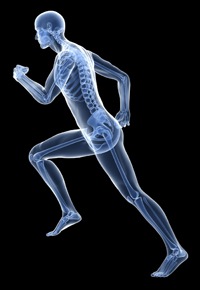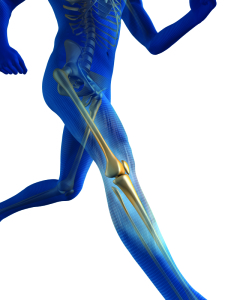Baker’s Cyst Treatment in Los Angeles
By Steven Meier
 A Baker’s cyst is a condition where joint fluid builds up behind the knee and causes a lump, or bump behind the knee. Excessive swelling of the knee causes this to happen, as the swelling increases the internal pressure of the knee and pushes fluid out of the joint into the space behind the knee. Baker’s cysts are painful, and this pain tends to worsen when patients in Los Angeles are active or fully flexing and/or extending the joint.
A Baker’s cyst is a condition where joint fluid builds up behind the knee and causes a lump, or bump behind the knee. Excessive swelling of the knee causes this to happen, as the swelling increases the internal pressure of the knee and pushes fluid out of the joint into the space behind the knee. Baker’s cysts are painful, and this pain tends to worsen when patients in Los Angeles are active or fully flexing and/or extending the joint.
Sometimes a Baker’s cyst will cause no pain, and the patient in Los Angeles might not even know there is a Baker’s cyst behind their knee. However, most people with Baker’s cysts will experience some combination of the following symptoms, which may worsen over time due to activity or prolonged standing:
- Knee pain
- Stiffness
- Swelling behind the knee, and sometimes, in the lower leg
You should talk to your doctor or an orthopedic specialist if you notice a swollen bump or experience pain and swelling in the area behind your knee. There is a possibility that a bump behind your knee is a sign of a more serious condition and not just a fluid-filled cyst. You might need arthroscopic knee surgery to fix the problem.
Dr. Meier has helped countless patients put an end to their serious orthopedic conditions through in-depth medical procedures designed to put an end to pain and physical limitations. Contact Dr. Steven W. Meier for orthopedic services and sports medicine and schedule an appointment by calling (310) 777-7845 or filling out the online contact form today.
What Causes a Baker’s Cyst?

Also referred to as a popliteal cyst, Baker’s cysts are usually linked to a problem within the knee joint. These joint conditions can sometimes lead to an excess of fluid in the knee, which in turn can lead to a Baker’s cyst. Some conditions that have been known to cause Baker’s cysts include:
- Cartilage or Meniscus tears
- Osteoarthritis of the knee
- Rheumatoid arthritis
The reason Baker’s cysts develop is a result of the presence of a lubricating fluid known as synovial fluid within the knee. Like motor oil in a car engine, synovial fluid helps reduce friction in the knee joint and allows the lower leg to move smoothly. When too much of this fluid builds up in the back of the joint (usually within the popliteal bursa), a Baker’s cyst can form.
Treatment for Baker’s cysts in Los Angeles typically involves treating the underlying knee problem. This will reduce the swelling and provide pain relief and increased function.
Complications
Though it’s rare, a Baker’s cyst can burst and allow synovial fluid to leak into the calf region. This can cause the following symptoms:
- Sharp pain in the knee
- Swelling
- Redness of the calf
- Sensation of water running down the calf
Please note that these are similar symptoms to what patients might feel with a blood clot in a leg vein. If you experience swelling or redness in your calf region, contact your doctor immediately for a medical evaluation in case something more serious (i.e. possible blood clot or tumor) is causing your symptoms.
Popliteal Cyst Diagnosis
 A physical exam usually suffices for a Baker’s cyst diagnosis. However, because the symptoms of a Baker’s cyst are very similar to more serious medical conditions, the orthopedist might want to have some imaging tests performed, including an ultrasound or an MRI, to rule out all other possibilities, and determine what might be causing the Baker’s cyst formation.
A physical exam usually suffices for a Baker’s cyst diagnosis. However, because the symptoms of a Baker’s cyst are very similar to more serious medical conditions, the orthopedist might want to have some imaging tests performed, including an ultrasound or an MRI, to rule out all other possibilities, and determine what might be causing the Baker’s cyst formation.
For more information on knee surgery and diagnosis, view ou orthopedic surgery videos at the Patient Education Center.
Baker’s Cyst Treatment Options
Typically, when orthopedic doctors treat underlying knee conditions, Baker’s cysts clear up on their own. There are, however, treatment options to help reduce pain and swelling.
Non-surgical treatment options include scaling back temporarily on physical activities, over-the-counter medications that relieve pain and reduce swelling, and RICE protocol. RICE stands for rest, ice, compression, and elevation:
- Rest the affected area.
- Ice the inflamed area.
- Compress the area (e.g. your knee) with a wrap, sleeve or brace.
- Elevate the affected area (above the level of your heart) whenever possible, especially at night.
For more serious and symptomatic Baker’s cysts, doctors in Los Angeles might also recommend one or more of the following treatment options:
- Cortisone injection into the joint to reduce inflammation and relieve pain
- Needle aspiration, during which fluid is drained from the knee by a needle
- Physical therapy, including ice, range-of-motion exercises and strengthening exercises
Read more about Baker’s Cysts knee fluid build-ups from WebMD.com.
Contact a Doctor about Your Knee Fluid Buildup
At Meier Orthopedic Sports and Regenerative Medicine, we specialize in treating joint problems. If you have a Baker’s cyst and want relief from your symptoms, contact our Los Angeles doctors today at (310) 777-7845.
Next, find out how Dr. Meier treats kneecap pain.
